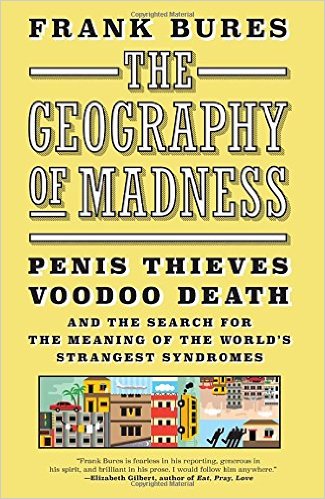It used to be that when I looked in the mirror, I saw many things: a body; a collection of cells; a fantastic kind of machinery. I didn’t see these things because they were a reflection of reality, or because the body and brain are, in fact, machines. I saw them because I was born in America, and that is my culture.

WHAT I LEFT OUT is a recurring feature in which book authors are invited to share anecdotes and narratives that, for whatever reason, did not make it into their final manuscripts. In this installment, writer Frank Bures shares a story that didn’t make it into his new book, “The Geography of Madness: Penis Thieves, Voodoo Death, and the Search for the Meaning of the World’s Strangest Syndromes.”
In our country, we have what’s known as a mechanistic understanding of our bodies. We imagine ourselves to be machines made of meat and bone. We see the doctor as a mechanic whose job is to find the broken parts and fix them. For at least a century this has been our primary metaphor for talking about sickness and health, about how our bodies work and break down. In its popular 1960s television special, National Geographic flatly described the human body as “The Incredible Machine.”
The body is incredible, but my view of it as a machine — the validity of that metaphor — started to break down in the process of researching my book, “The Geography of Madness,” about the so-called “cultural syndromes.”
“Of course, one cannot think without metaphors,” Susan Sontag wrote in her 1989 essay, “AIDS and its Metaphors,” “But that does not mean there aren’t some metaphors we might well abstain from or try to retire.”
Sontag was, at that time, on a crusade against the military metaphor that pervades medicine. Her initial wrath was centered on the “War on Cancer,” of which she was a part, having been diagnosed with (and recovered from) the disease herself. But she felt the military mindset introduced unhelpful meanings into our attempt to cure what was simply an illness. “We are not being invaded,” she wrote. “The body is not a battlefield. The ill are neither unavoidable casualties nor the enemy.”
Sontag was right to challenge the metaphor. But the idea that illness is something that invades the body has deep roots in American thinking, as the American science writer Lynn Payer noted her in book, “Medicine and Culture.” Her chapter on America is titled, “The Virus in the Machine.”
Payer noted that technology-loving Americans have long seen the body in mechanical terms, citing metaphors back to the 1920s that cast it as a car needing a yearly tune up. When we think about our blood, we see plumbing: a pump (the heart) and pipes (the veins and arteries), which may explain our unusual penchant for bypass surgery and the reason the artificial heart was invented in America, not elsewhere. It might also explain why the vaunted artificial heart failed as an easy fix for a damaged human heart. In its way, it represented a failure of the metaphor. The heart is far complex more than just a pump pushing around blood.
Such mechanical imagery contrasts sharply with equally visual French metaphors, which Payer observes are rooted in the idea of the body as terrain, or the ground in which things grow. This notion evokes a vineyard, and French physicians tend to see illness as something that needs fertile ground in which to take root. As a result, much of French medicine is geared toward fortifying the terrain to make it more difficult for illness to thrive. In America, the terrain is carpet bombed.
Metaphors do not control our thoughts, but they can set boundaries around the way we think. The purpose of a metaphor is to take something we know and use it to explain something we don’t. The word has its roots in the Greek metapherein, meaning to transfer or carry. By linking two disparate things, a metaphor carries some quality from one to the other. It takes the concreteness of something we can imagine (like war) and carries it to something we can’t (like cancer).
The implications of our metaphors are real. America’s defensive, military metaphors have driven the aggressiveness of American medicine, pushing doctors and patients to over-treatment. They fuel our desire to always do something rather than nothing, even when there is nothing to be done. Our military mindset causes us to treat death as defeat and life as victory. It helps explain why billions of dollars are spent on keeping people alive in their last months, regardless of the quality of those lives. It is why we’ve been terrible at dealing with chronic conditions (which cannot be vanquished) and until recently have simply ignored them rather than help people live with them.
Nonetheless, metaphors are inevitable, as Sontag observed. For the last century our machine metaphor has been sufficient to deal with infectious diseases. But in other areas it is less useful. And in the realm of mental health, it is practically useless.
All of this began to bother me as I was researching syndromes in which our culture plays a strong role. I began to see how, in the same way we use machines to explain our body, we use them to explain the mind. As Rachel Aviv pointed out in her essay, “There is Only Awe,” science and technology has long given us our shorthand for our mental lives.
“In the 1600s, consciousness was like a clock, in perpetual and regular motion,” she writes. “Two hundred years later, when chemistry was the fashionable science, consciousness was a compound structure that could be broken down into its elements—individual sensations and thoughts. By the industrial era, when Freud was beginning to develop his theories of mind, consciousness functioned like a steam engine: when emotional pressure and strain became too great, secret underground forces were recklessly released.”
Today our metaphor of choice for the mind (and the brain) is the computer. We talk about our neurology in terms of hard drives and hard wiring and programming. We speak of the brain in terms of circuits and processing and input and output. We imagine it to be a kind of large gray calculator.
This line of thinking carries the mechanistic qualities of the computer over to the mind—qualities which it doesn’t actually have. Conversely, it also transfers the emergent qualities of the mind back to our computers, fueling our overblown fears about Artificial Intelligence.
The deeper I got into these questions, the clearer the limits of the computer metaphor became. There were so many qualities that it could not bear, including those identified in some of today’s most important discoveries in epigenetics, neuroplasticity, the placebo and nocebo effects, all of which involve recursive processes where an organism changes itself or where an organism’s beliefs and choices alter its physiology.
This is where the computer metaphor begins to crash. Many of us, even those who admire the metaphor, sense this at some level. “The brain’s a computer,” said science philosopher Daniel Dennett in a 2013 interview, “but it’s so different from any computer that you’re used to. It’s not like your desktop or your laptop at all, and it’s not like your iPhone except in some ways. It’s a much more interesting phenomenon.”
Which is to say it’s not like a computer at all.
Using the mechanical model for the mind has long been known to be problematic. In 1977 the psychiatrist George Engel came up with the “biopsychosocial model” of mental health as an alternative to the mechanistic biomedical model. This did have some impact in steering American medicine toward patient-centered care (as opposed to doctor-centered care), and in the development of of psychoneuroendocrinology and psychoneuroimmunology.
Almost every year, someone tries to bring back the biopsychosocial model, citing new findings that don’t fit the old mold. But it has never really caught on. Accurate as it may be, it doesn’t make intuitive sense. It feels like a bunch of words crammed together. The real problem is not that it’s wrong. It’s that it has no metaphorical power, which ironically, is both its weakness and its strength.
Eventually I came across a similar idea, but one with more metaphorical heft. It came from the Canadian philosopher Ian Hacking. He called it the biolooping model, in which the body and mind affect each other in a feedback loop that is hard (though not always impossible) to disentangle. I believe this may be our best hope for a new medical model that can encompass the things we’re learning. It seems to capture the circle of causation that runs between our mind (not brain) and our body.
The image of a loop is better than no image at all, and a vast improvement on the old metaphor of a straight, mechanical line from body to mind. But useful as it is, there was another metaphor that kept coming into in my mind.
It was the image of water, of rivers, of waves, of currents. There was something about the way our stories and syndromes flow between us, how our beliefs run through us, that kept bring me back to these. Maybe it was the way flowing water is so powerful but also pliable, so unforgiving but also yielding. The way a river flows seemed best to reflect the way our convictions, our fears, our hopes, our microbes, our neurons moved through us. These are all fluid processes. In the same way water rises and falls, speeds and slows, so do they.
So today, that’s what I see when I look in the mirror. I don’t see a car or a computer or a machine of any kind. Instead I see a person, a swirling self, paddling madly down a stream, steering around rocks, and always struggling to manage the flow of everything, including himself.
Frank Bures is a Minneapolis-based writer whose work has appeared in Washington Post Magazine, Harper’s Magazine, Outside, and New Republic, among other publications. “The Geography of Madness” is his first book.










